Trade-Offs and Synergies in Ecosystem Service within the Three-Rivers Headwater Region, China
Abstract
:1. Introduction
2. Overview of Research Area
2.1. TRHR Ecological Protection and Restoration
2.2. TRHR Climate Change
2.3. TRHR LULC between 2000 and 2012
3. Materials and Methods
3.1. Ecosystem Service Assessment
3.1.1. Water Yield Module
3.1.2. Sediment Delivery Ratio Module
3.1.3. Nutrient Delivery Ratio Module
3.1.4. Data
3.2. DMC
4. Results
4.1. The Temporal and Spatial Distribution of Ecosystem Services within the TRHR
4.1.1. NPP
4.1.2. Water Yield
4.1.3. Soil Conservation
4.1.4. P Export
4.2. Synergies between Ecosystem Services
4.2.1. Correlations
4.2.2. Synergies
5. Discussion
5.1. Key Factors Driving Changes in Ecosystem Services
5.1.1. Climate Change
5.1.2. Land Conversion
5.2. Relationships between TRHR Ecosystem Services
5.3. Uncertainties in Our Model-Based Assessment
5.4. Proposed Measures for the Sustainable Management of the TRHR
6. Conclusions
Acknowledgments
Author Contributions
Conflicts of Interest
Appendix A. Input Data of InVEST Models
Appendix A.1. Water Yield Module
Appendix A.2. Sediment Delivery Ratio Module
| LULC Type | C | P |
|---|---|---|
| Cultivated land | 0.300 | 1.000 |
| Forested land | 0.003 | 1.000 |
| Grassland | 0.020 | 1.000 |
| Rivers/lakes | 0.000 | 1.000 |
| Construction land | 0.000 | 1.000 |
| Unused land | 1.000 | 1.000 |
Appendix A.3. Nutrient Delivery Ratio Module
References
- Song, W.; Liu, M.L. Farmland conversion decreases regional and national land quality in China. Land Degrad. Dev. 2017, 28, 459–471. [Google Scholar] [CrossRef]
- Yu, G.; Chen, Z.; Zhang, L.; Peng, C.; Chen, J.; Piao, S.; Zhang, Y.; Niu, S.; Wang, Q.; Luo, Y.; et al. Recognizing the scientific mission of flux tower observation networks—Laying a solid scientific data foundation for solving ecological issues related to global change. J. Resour. Ecol. 2017, 8, 115–120. [Google Scholar]
- Ellis, E.C.; Klein Goldewijk, K.; Siebert, S.; Lightman, D.; Ramankutty, N. Anthropogenic transformation of the biomes, 1700 to 2000. Glob. Ecol. Biogeogr. 2010, 19, 589–606. [Google Scholar] [CrossRef]
- Alessa, L.; Chapin, F.S. Anthropogenic biomes: A key contribution to earth-system science. Trends Ecol. Evol. 2008, 23, 529–531. [Google Scholar] [CrossRef] [PubMed]
- Ellis, E.C.; Ramankutty, N. Putting people in the map: Anthropogenic biomes of the world. Front. Ecol. Environ. 2008, 6, 439–447. [Google Scholar] [CrossRef]
- Song, W.; Deng, X.Z. Effects of urbanization-induced cultivated land loss on ecosystem services in the North China Plain. Energies 2015, 8, 5678–5693. [Google Scholar] [CrossRef]
- Song, W.; Pijanowski, B.C.; Tayyebi, A. Urban expansion and its consumption of high-quality farmland in Beijing, China. Ecol. Indic. 2015, 54, 60–70. [Google Scholar] [CrossRef]
- Xiao, Y.; An, K.; Xie, G.; Lu, C. Evaluation of ecosystem services provided by 10 typical rice paddies in China. J. Resour. Ecol. 2011, 2, 328–337. [Google Scholar]
- Daily, G. Nature’s Services: Societal Dependence on Natural Ecosystems; Island Press: Washington, DC, USA, 1997. [Google Scholar]
- Bennett, E.M.; Peterson, G.D.; Gordon, L.J. Understanding relationships among multiple ecosystem services. Ecol. Lett. 2009, 12, 1394–1404. [Google Scholar] [CrossRef] [PubMed]
- Millennium Ecosystem Assessment. Ecosystems and Human Wellbeing: A Framework for Assessment; Island Press: Washington, DC, USA, 2003. [Google Scholar]
- Song, W.; Deng, X.; Yuan, Y.; Wang, Z.; Li, Z. Impacts of land-use change on valued ecosystem services on the rapidly urbanized North China Plain. Ecol. Model. 2015, 318, 245–253. [Google Scholar] [CrossRef]
- Lal, R. Soil carbon sequestration impacts on global climate change and food security. Science 2004, 304, 1623–1627. [Google Scholar] [CrossRef] [PubMed]
- Metzger, M.; Rounsevell, M.; Acosta-Michlik, L.; Leemans, R.; Schröter, D. The vulnerability of ecosystem services to land use change. Agric. Ecosyst. Environ. 2006, 114, 69–85. [Google Scholar] [CrossRef]
- Ke, X.; Zhan, J.; Ma, E.; Huang, J. Regional climate impacts of future urbanization in China. In Land Use Impacts on Climate; Springer: Berlin/Heidelberg, Germany, 2014; pp. 167–206. [Google Scholar]
- Schroter, D.; Cramer, W.; Leemans, R.; Prentice, I.C.; Araujo, M.B.; Arnell, N.W.; Bondeau, A.; Bugmann, H.; Carter, T.R.; Gracia, C.A.; et al. Ecosystem service supply and vulnerability to global change in Europe. Science 2005, 310, 1333–1337. [Google Scholar] [CrossRef] [PubMed]
- Cramer, W.; Bondeau, A.; Woodward, F.I.; Prentice, I.C.; Betts, R.A.; Brovkin, V.; Cox, P.M.; Fisher, V.; Foley, J.A.; Friend, A.D.; et al. Global response of terrestrial ecosystem structure and function to CO2 and climate change: Results from six dynamic global vegetation models. Glob. Chang. Biol. 2001, 7, 357–373. [Google Scholar] [CrossRef]
- Holling, C.S. The resilience of terrestrial ecosystems: Local surprise and global change. Sustain. Dev. Biosph. 1986, 14, 292–317. [Google Scholar]
- Liu, F.; Zhang, H.; Zhang, Y.; Zhou, Q.; Duo, H. A study on the resources using and environment policy in the Three River’s source nature reserve. J. Qinghai Norm. Univ. Nat. Sci. 2005, 2, 86–91. (In Chinese) [Google Scholar]
- Jiang, C.; Li, D.; Wang, D.; Zhang, L. Quantification and assessment of changes in ecosystem service in the Three-River headwaters region, China as a result of climate variability and land cover change. Ecol. Indic. 2016, 66, 199–211. [Google Scholar] [CrossRef]
- Lawler, J.J.; Lewis, D.J.; Nelson, E.; Plantinga, A.J.; Polasky, S.; Withey, J.C.; Helmers, D.P.; Martinuzzi, S.; Pennington, D.; Radeloff, V.C. Projected land-use change impacts on ecosystem services in the United States. Proc. Natl Acad. Sci. USA 2014, 111, 7492–7497. [Google Scholar] [CrossRef] [PubMed]
- Zhang, J.J.; Fu, M.C.; Zhang, Z.Y.; Tao, J.; Fu, W. A trade-off approach of optimal land allocation between socio-economic development and ecological stability. Ecol. Model. 2014, 272, 175–187. [Google Scholar] [CrossRef]
- Jia, X.Q.; Fu, B.J.; Feng, X.M.; Hou, G.H.; Liu, Y.; Wang, X.F. The trade-off and synergy between ecosystem services in the grain-for-green areas in Northern Shaanxi, China. Ecol. Indic. 2014, 43, 103–113. [Google Scholar] [CrossRef]
- Tallis, H.; Kareiva, P.; Marvier, M.; Chang, A. An ecosystem services framework to support both practical conservation and economic development. Proc. Natl Acad. Sci. USA 2008, 105, 9457–9464. [Google Scholar] [CrossRef] [PubMed]
- Xie, H.; Yao, G.; Liu, G. Spatial evaluation of the ecological importance based on gis for environmental management: A case study in Xingguo County of China. Ecol. Indic. 2015, 51, 3–12. [Google Scholar] [CrossRef]
- Emily, N.; Georginam, M.; Paulr, A.; Giles, A.; Simon, B.; Tom, C.; Robertm, E.; Johne, F.; Tobya, G.; James, G. Priority research areas for ecosystem services in a changing world. J. Appl. Ecol. 2009, 46, 1139–1144. [Google Scholar]
- Dobson, A.; Lodge, D.; Alder, J.; Cumming, G.S.; Keymer, J.; Mcglade, J.; Mooney, H.; Rusak, J.A.; Sala, O.; Wolters, V. Habitat loss, trophic collapse, and the decline of ecosystem services. Ecology 2006, 87, 1915–1924. [Google Scholar] [CrossRef]
- Carpenter, S.R.; Bennett, E.M.; Peterson, G.D. Scenarios for ecosystem services: An overview. Ecol. Soc. 2006, 11, 1599–1604. [Google Scholar] [CrossRef]
- Bryan, B.A. Incentives, land use, and ecosystem services: Synthesizing complex linkages. Environ. Sci. Policy 2013, 27, 124–134. [Google Scholar] [CrossRef]
- Coggan, A.; Whitten, S.M.; Bennett, J. Influences of transaction costs in environmental policy. Ecol. Econ. 2010, 69, 1777–1784. [Google Scholar] [CrossRef]
- Villamagna, A.M.; Angermeier, P.L.; Bennett, E.M. Capacity, pressure, demand, and flow: A conceptual framework for analyzing ecosystem service provision and delivery. Ecol. Complex. 2013, 15, 114–121. [Google Scholar] [CrossRef]
- Li, S.; Zhang, C.; Liu, J.; Zhu, W.; Ma, C.; Wang, J. The trade-offs and synergies of ecosystem services: Research progress, development trend, and themes of geography. Geogr. Res. 2013, 32, 1379–1390. [Google Scholar]
- Turner, K.G.; Odgaard, M.V.; Bocher, P.K.; Dalgaard, T.; Svenning, J.C. Bundling ecosystem services in Denmark: Trade-offs and synergies in a cultural landscape. Landsc. Urban Plan. 2014, 125, 89–104. [Google Scholar] [CrossRef]
- Deng, X.Z.; Li, Z.H.; Gibson, J. A review on trade-off analysis of ecosystem services for sustainable land-use management. J. Geogr. Sci. 2016, 26, 953–968. [Google Scholar] [CrossRef]
- Briner, S.; Huber, R.; Bebi, P.; Elkin, C.; Schmatz, D.; Grêt-Regamey, A. Trade-offs between ecosystem services in a mountain region. Ecol. Soc. 2013, 18, 35. [Google Scholar] [CrossRef]
- Jiang, C.; Li, D.; Gao, Y.; Liu, W.; Zhang, L. Impact of climate variability and anthropogenic activity on streamflow in the Three-Rivers Headwater region, Tibetan Plateau, China. Theor. Appl. Climatol. 2017, 129, 667–681. [Google Scholar] [CrossRef]
- Jiang, C.; Zhang, L. Effect of ecological restoration and climate change on ecosystems: A case study in the Three-Rivers Headwater region, China. Environ. Monit. Assess. 2016, 188, 382. [Google Scholar] [CrossRef] [PubMed]
- Xu, X.L.; Xiao, T.; Zhan, Z.M.; Tian, J.L.; Ge, J.S. Atlas of Remote Sensing for Ecosystems in the “Three Rivers Headwaters” Region of Qinghai Province; Star Map Press: Beijing, China, 2015. [Google Scholar]
- Jiang, C.; Zhang, L.B. Ecosystem change assessment in the Three-River Headwater region, China: Patterns, causes, and implications. Ecol. Eng. 2016, 93, 24–36. [Google Scholar] [CrossRef]
- Wang, Z.Q.; Zhang, Y.Z.; Yang, Y.; Zhou, W.; Gang, C.C.; Zhang, Y.; Li, J.L.; An, R.; Wang, K.; Odeh, I.; et al. Quantitative assess the driving forces on the grassland degradation in the Qinghai-Tibet Plateau, in China. Ecol. Inform. 2016, 33, 32–44. [Google Scholar] [CrossRef]
- Zhang, Y.; Zhang, C.; Wang, Z.; Chen, Y.; Gang, C.; An, R.; Li, J. Vegetation dynamics and its driving forces from climate change and human activities in the Three-River Source Region, China from 1982 to 2012. Sci. Total Environ. 2016, 563–564, 210–220. [Google Scholar] [CrossRef] [PubMed]
- Li, S.; Wang, Z.; Zhang, Y.; Wang, Y.; Liu, F. Comparison of socioeconomic factors between surrounding and non-surrounding areas of the Qinghai-Tibet railway before, and after, its construction. Sustainability 2016, 8, 776. [Google Scholar] [CrossRef]
- Li, X.; Brierley, G.; Shi, D.; Xie, Y.; Sun, H. Ecological protection and restoration in Sanjiangyuan national nature reserve, Qinghai Province, China. In Perspectives on Environmental Management and Technology in Asian River Basins; Springer: Berlin/Heidelberg, Germany, 2012; pp. 93–120. [Google Scholar]
- Fang, Y. Managing the Three-Rivers Headwater region, China: From ecological engineering to social engineering. Ambio 2013, 42, 566–576. [Google Scholar] [CrossRef] [PubMed]
- Sharp, R.; Tallis, H.; Ricketts, T.; Guerry, A.; Wood, S.; Chaplin-Kramer, R.; Nelson, E.; Ennaanay, D.; Wolny, S.; Olwero, N. InVEST 3.3.2 User’s Guide. In The Natural Capital Project, Stanford; Stanford University Press: Redwood, CA, USA, 2014. [Google Scholar]
- Renard, K.G. Predicting soil erosion by water: A guide to conservation planning with the revised universal soil loss equation (RUSLE). In Agricultural Handbook No. 703; U.S. Department of Agriculture, U.S. Government Printing Office: Washington, DC, USA, 1997; p. 404. [Google Scholar]
- Chen, Z.; Shao, Q.; Liu, J.; Wang, J. Analysis of net primary productivity of terrestrial vegetation on the Qinghai-Tibet Plateau, based on Modis remote sensing data. Sci. China Earth Sci. 2012, 55, 1306–1312. [Google Scholar] [CrossRef]
- Hutchinson, M.F.; Xu, T. Anusplin Version 4.2 User Guide; Centre for Resource and Environmental Studies, The Australian National University: Canberra, Australia, 2004; Available online: http://fennerschool.anu.edu.au/files/anusplin44.pdf (accessed on 3 August 2017).
- Nachtergaele, F.; van Velthuizen, H.; Verelst, L.; Batjes, N.; Dijkshoorn, K.; van Engelen, V.; Fischer, G.; Jones, A.; Montanarella, L.; Petri, M. Harmonized World Soil Database; Version 1.2; Wageningen: Rome, Italy, 2009. [Google Scholar]
- The Ministry of Water Resources of the People’s Republic of China. Qinghai Water Resources Bulletin; Qinghai Provincial Department of Water Resources: Qinghai, China, 2000; p. 31.
- The Ministry of Water Resources of the People’s Republic of China. Qinghai Water Resources Bulletin; Qinghai Provincial Department of Water Resources: Qinghai, China, 2012; p. 31.
- Wen, L. Assessment of Soil Conservation in Sanjiangyuan Based on the Invest Model; Capital Normal University: Beijing, China, 2012. [Google Scholar]
- Nelson, G.C.; Dobermann, A.; Nakicenovic, N.; O’Neill, B. Anthropogenic drivers of ecosystem change: An overview. Ecol. Soc. 2006, 11, 29. [Google Scholar] [CrossRef]
- Lead, C.; Nelson, G.C.; Bennett, E. Drivers of change in ecosystem condition and services. Ecosyst. Hum. Well-Being 2005, 2, 172–222. [Google Scholar]
- Oliver, T.H.; Morecroft, M.D. Interactions between climate change and land use change on biodiversity: Attribution problems, risks, and opportunities. Wiley Interdiscip. Rev. Clim. Chang. 2014, 5, 317–335. [Google Scholar] [CrossRef] [Green Version]
- Bellard, C.; Bertelsmeier, C.; Leadley, P.; Thuiller, W.; Courchamp, F. Impacts of climate change on the future of biodiversity. Ecol. Lett. 2012, 15, 365–377. [Google Scholar] [CrossRef] [PubMed]
- Zhang, Y.; Liu, B.; Zhang, Q.; Xie, Y. Effect of different vegetation types on soil erosion by water. Acta Bot. Sin. 2002, 45, 1204–1209. [Google Scholar]
- Laker, M. Advances in soil erosion, soil conservation, land suitability evaluation and land use planning research in South Africa, 1978–2003. S. Afr. J. Plant. Soil 2004, 21, 345–368. [Google Scholar] [CrossRef]
- Sharps, K.; Masante, D.; Thomas, A.; Jackson, B.; Redhead, J.; May, L.; Prosser, H.; Cosby, B.; Emmett, B.; Jones, L. Comparing strengths and weaknesses of three ecosystem services modelling tools in a diverse UK river catchment. Sci. Total Environ. 2017, 584, 118–130. [Google Scholar] [CrossRef] [PubMed]
- Zheng, Z.; Fu, B.; Hu, H.; Sun, G. A method to identify the variable ecosystem services relationship across time: A case study in the Yanhe Basin, China. Landsc. Ecol. 2014, 29, 1689–1696. [Google Scholar] [CrossRef]
- Tian, Y.; Wang, S.; Bai, X.; Luo, G.; Xu, Y. Trade-offs among ecosystem services in a typical karst watershed, SW China. Sci. Total Environ. 2016, 566, 1297–1308. [Google Scholar] [CrossRef] [PubMed]
- Zheng, Z.; Fu, B.; Feng, X. GIS-based analysis for hotspot identification of trade-off between ecosystem services: A case study in the Yanhe Basin, China. Chin. Geogr. Sci. 2016, 26, 466–477. [Google Scholar] [CrossRef]
- Howe, C.; Suich, H.; Vira, B.; Mace, G.M. Creating win-wins from trade-offs? Ecosystem services for human well-being: A meta-analysis of ecosystem service trade-offs and synergies in the real world. Glob. Environ. Chang. 2014, 28, 263–275. [Google Scholar] [CrossRef]
- Farber, S.C.; Costanza, R.; Wilson, M.A. Economic and ecological concepts for valuing ecosystem services. Ecol. Econ. 2002, 41, 375–392. [Google Scholar] [CrossRef]
- Van Jaarsveld, A.; Biggs, R.; Scholes, R.; Bohensky, E.; Reyers, B.; Lynam, T.; Musvoto, C.; Fabricius, C. Measuring conditions and trends in ecosystem services at multiple scales: The southern African millennium ecosystem assessment (SAFMA) experience. Philos. Trans. R. Soc. Lond. B Biol. Sci. 2005, 360, 425–441. [Google Scholar] [CrossRef] [PubMed]
- Zhang, L.; Hickel, K.; Dawes, W.; Chiew, F.H.; Western, A.; Briggs, P. A rational function approach for estimating mean annual evapotranspiration. Water Resour. Res. 2004, 40. [Google Scholar] [CrossRef]
- Zhou, W.; Liu, G.; Pan, J.; Feng, X. Distribution of available soil water capacity in China. J. Geogr. Sci. 2005, 15, 3–12. [Google Scholar] [CrossRef]
- Allen, R.G.; Pereira, L.S.; Raes, D.; Smith, M. Crop evapotranspiration-guidelines for computing crop water requirements-FAO irrigation and drainage paper 56. FAO Rome 1998, 300, D05109. [Google Scholar]
- Williams, J.; Arnold, J. A system of erosion—Sediment yield models. Soil Technol. 1997, 11, 43–55. [Google Scholar] [CrossRef]
- Zhang, W.; Fu, J. Rain erositivity estimation under different rainfall amount. Resour. Sci. 2002, 25, 35–41. [Google Scholar]
- Liu, B.; Zhang, K.; Xie, Y. An empirical soil loss equation. In Proceedings of the 12th International Soil Conservation Organization Conference, Beijing, China, 26–31 May 2002; p. 15. (In Chinese). [Google Scholar]
- Li, S.; Wang, Z.; Zhang, Y. Crop cover reconstruction and its effects on sediment retention in the tibetan plateau for 1900–2000. J. Geogr. Sci. 2017, 27, 786–800. [Google Scholar] [CrossRef]
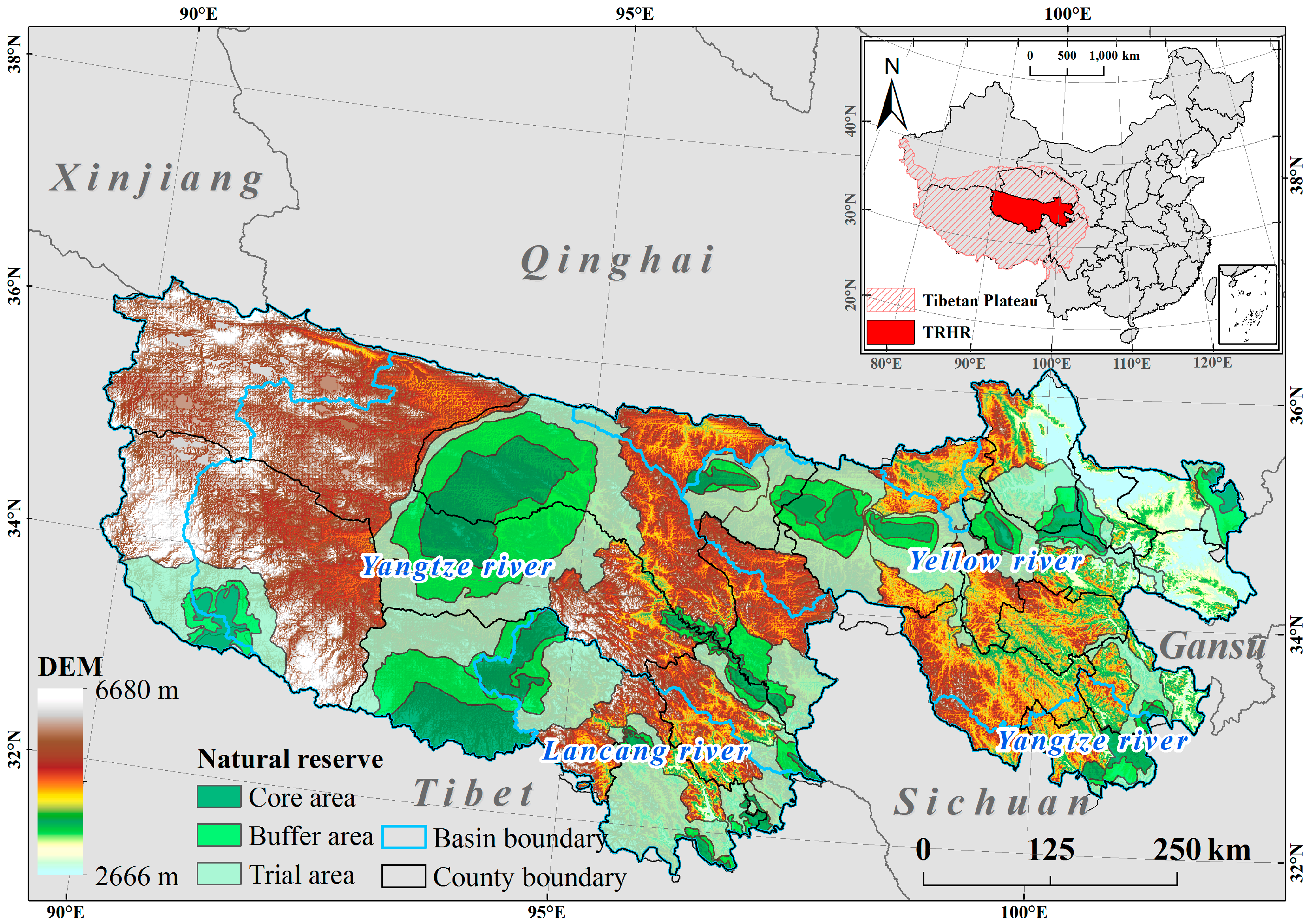
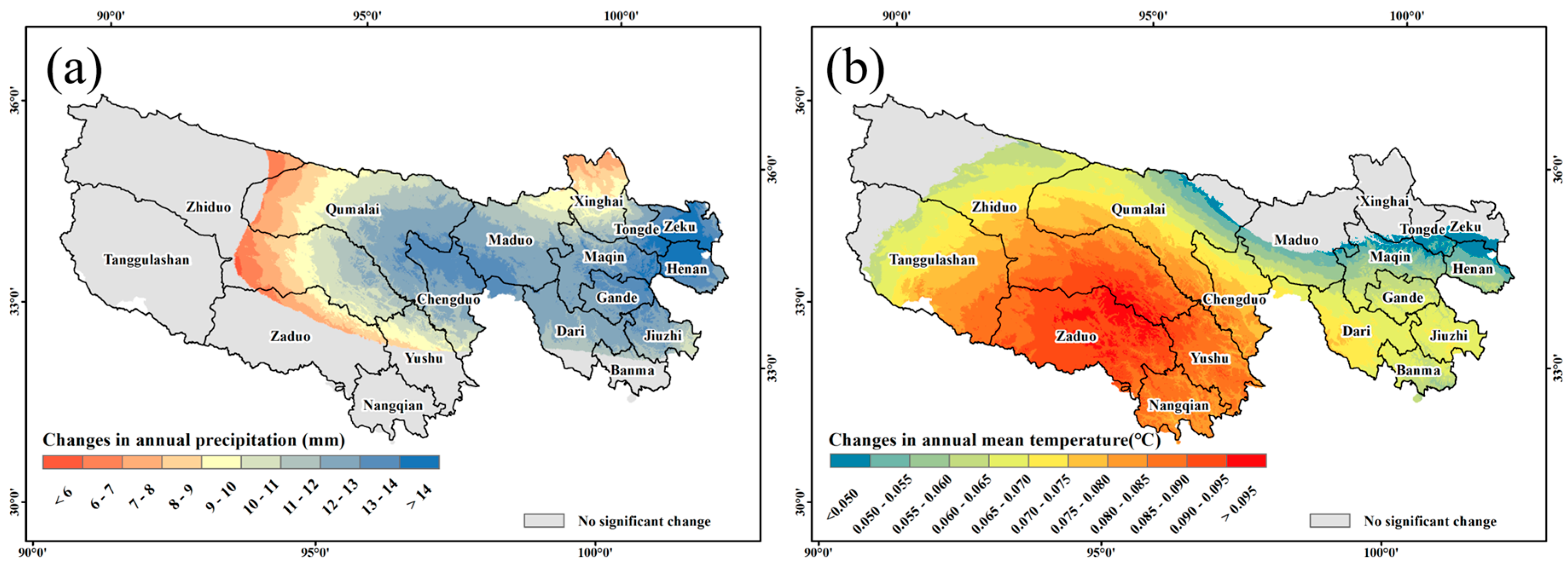
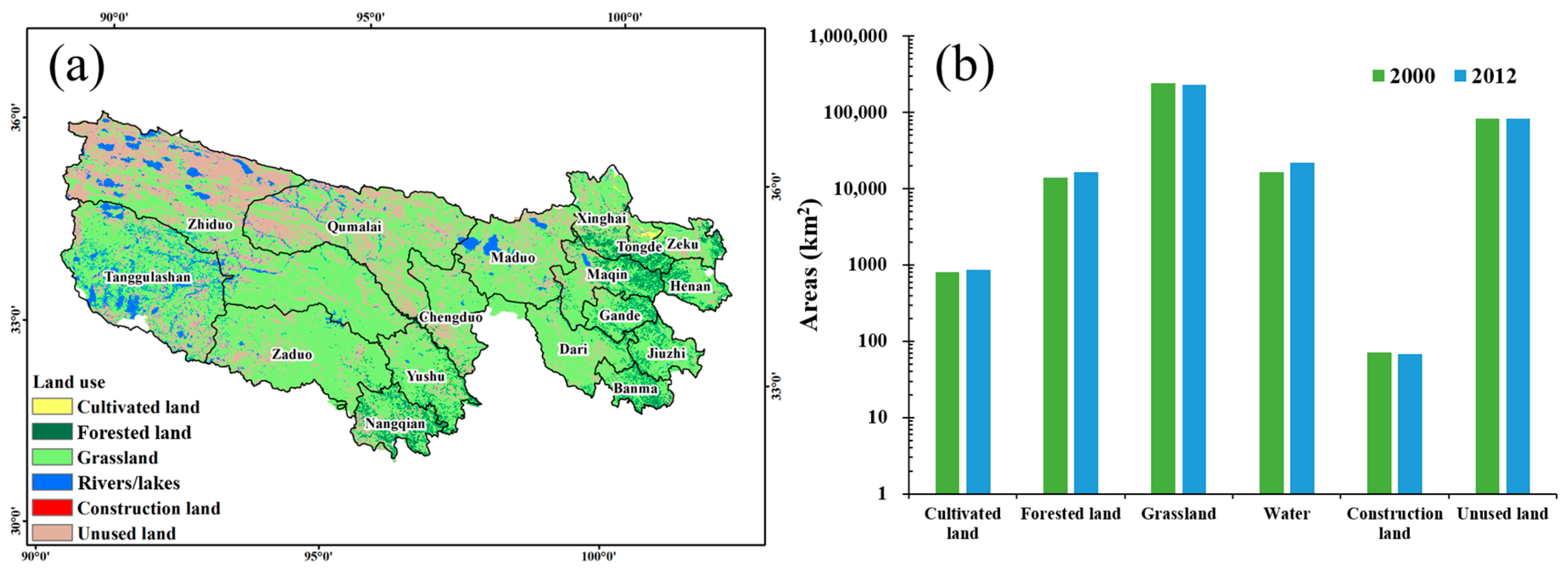
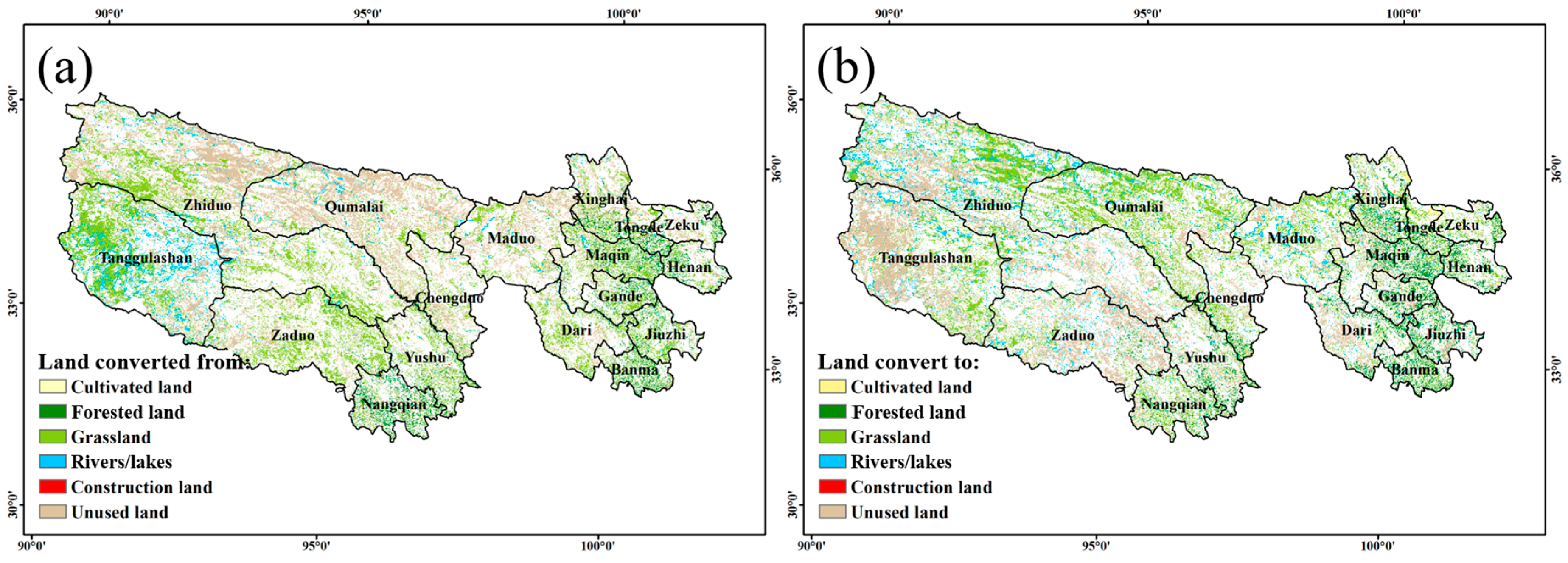

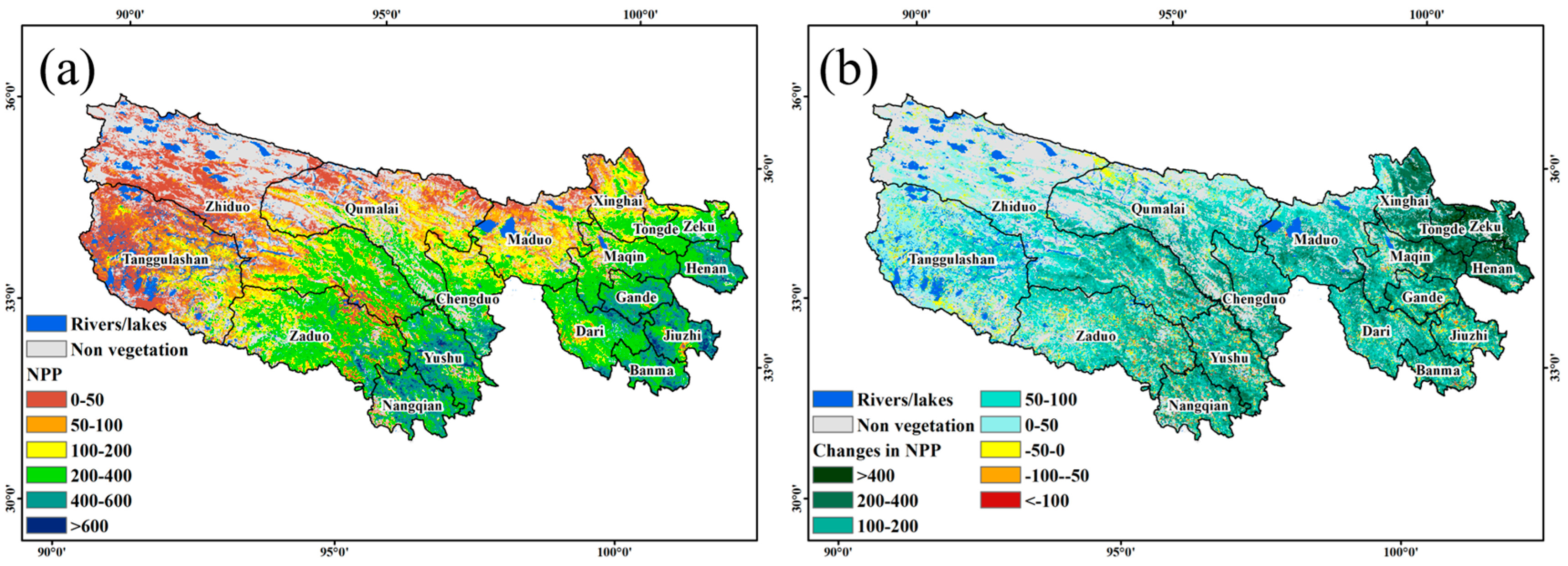

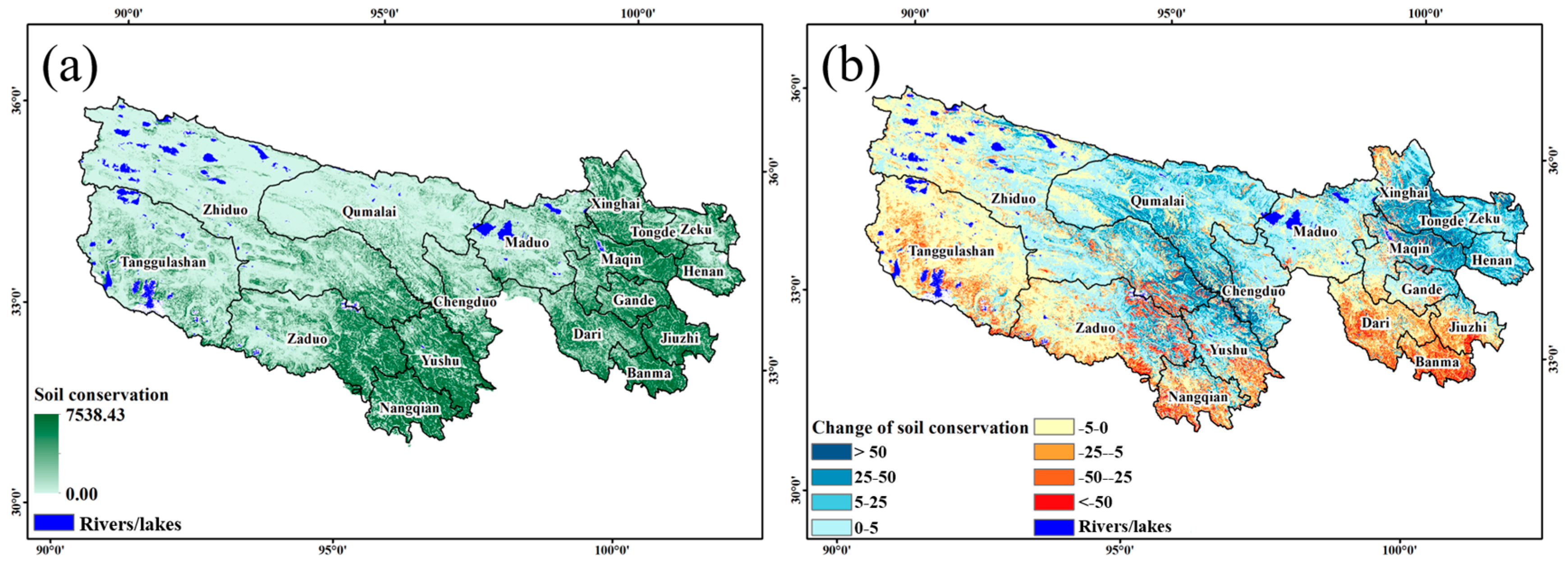
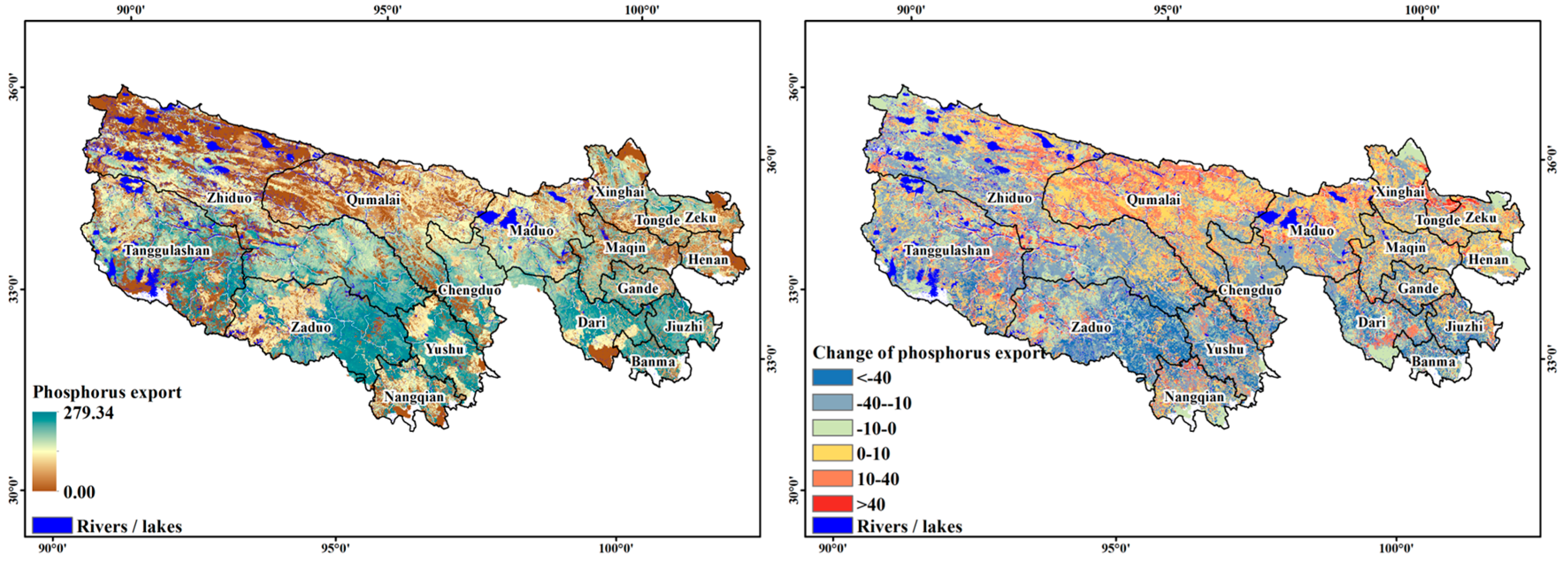
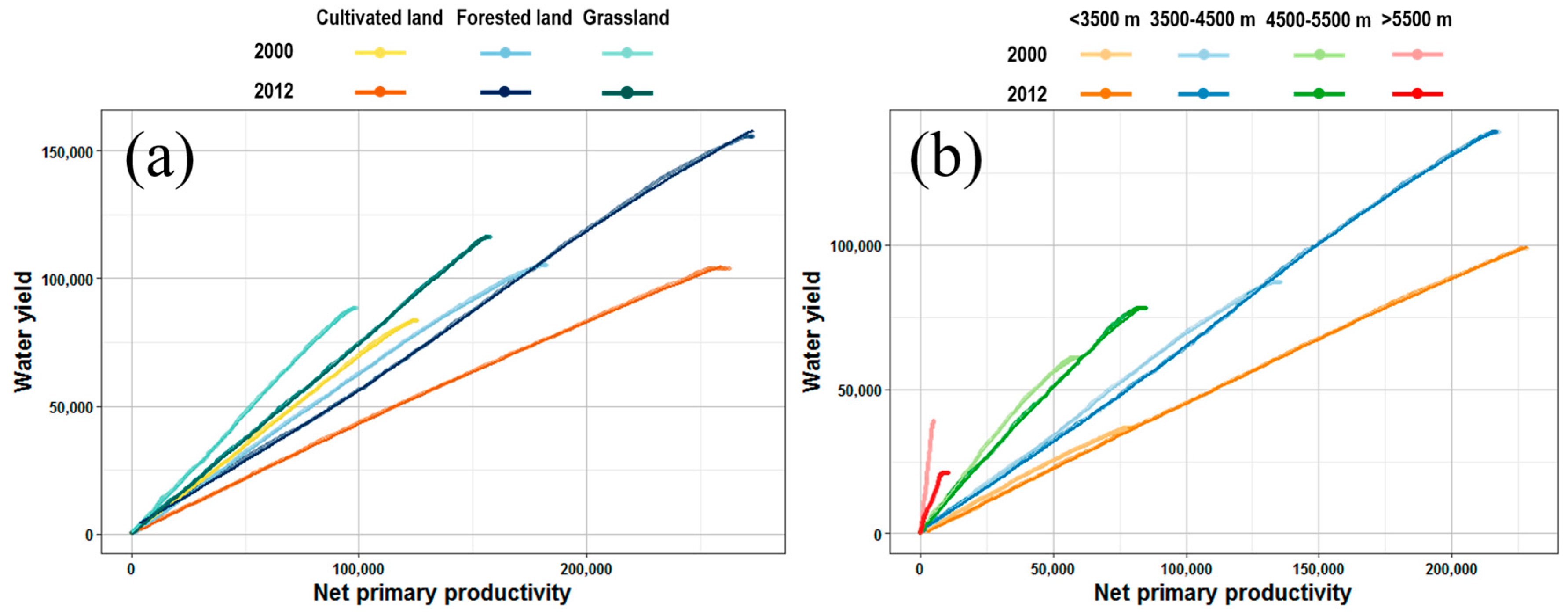
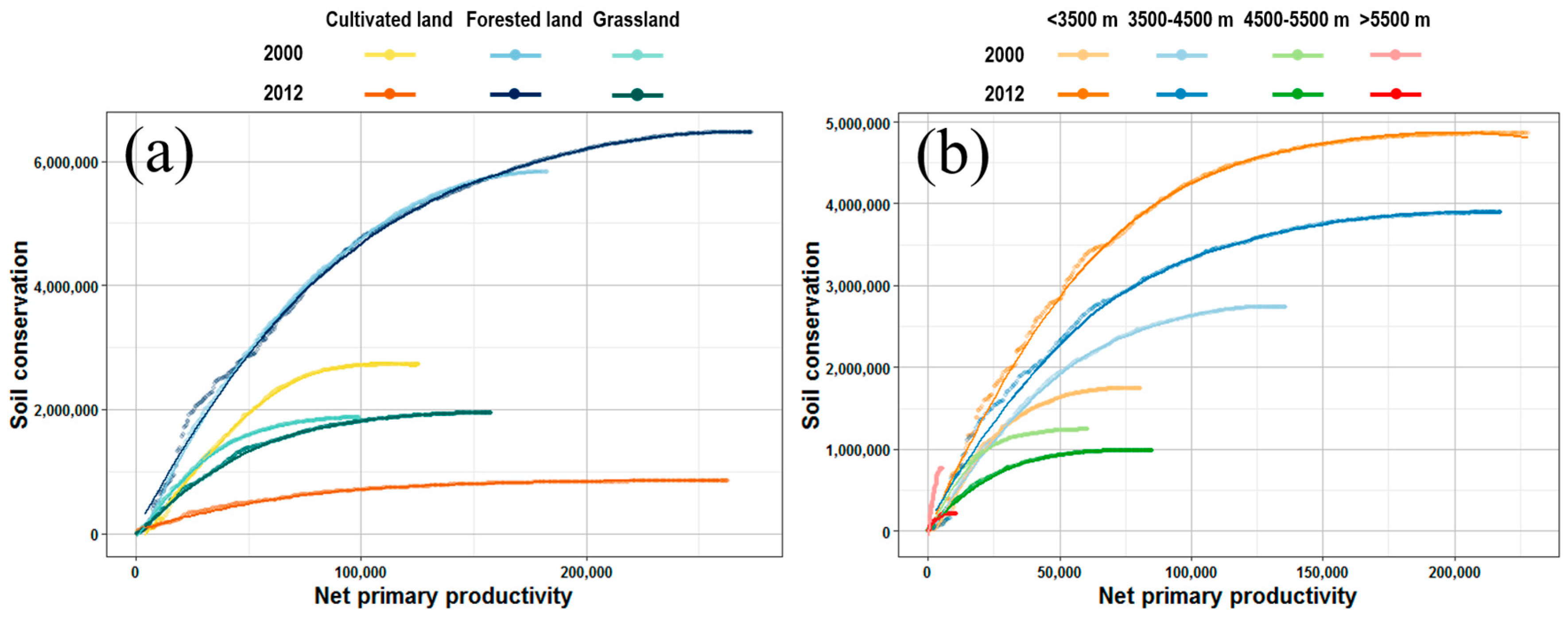
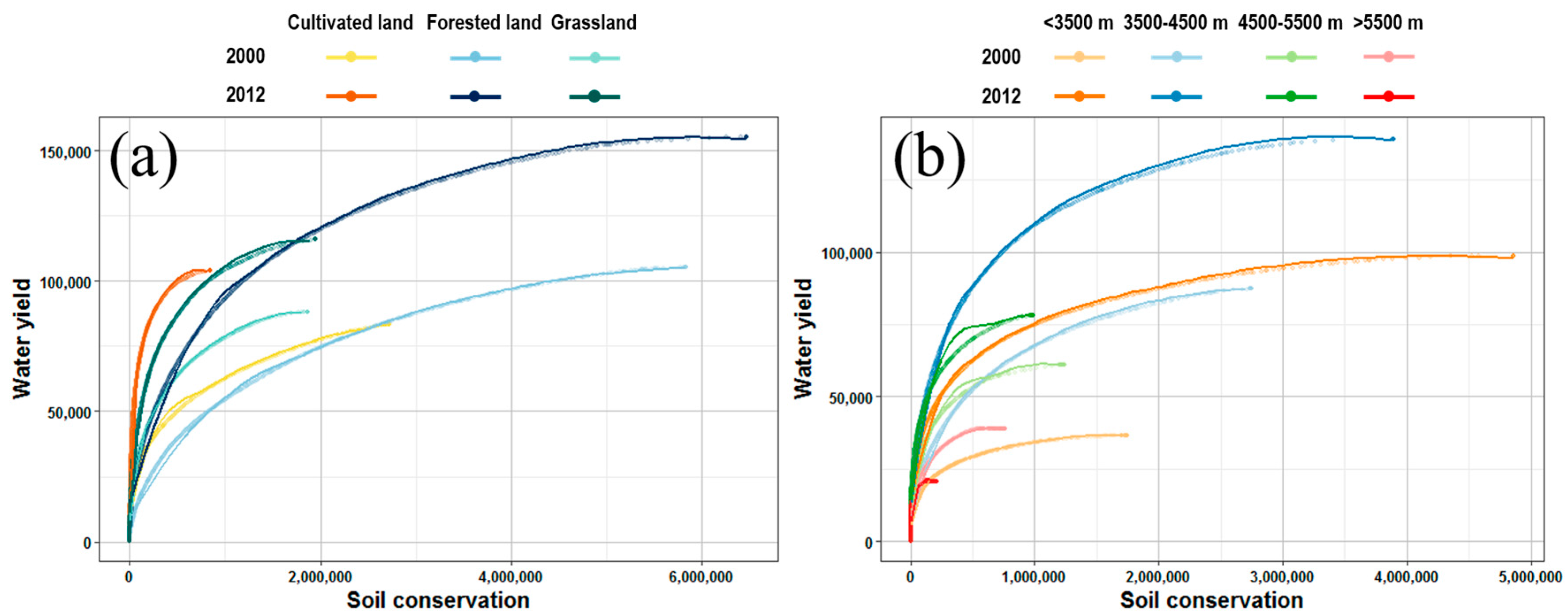
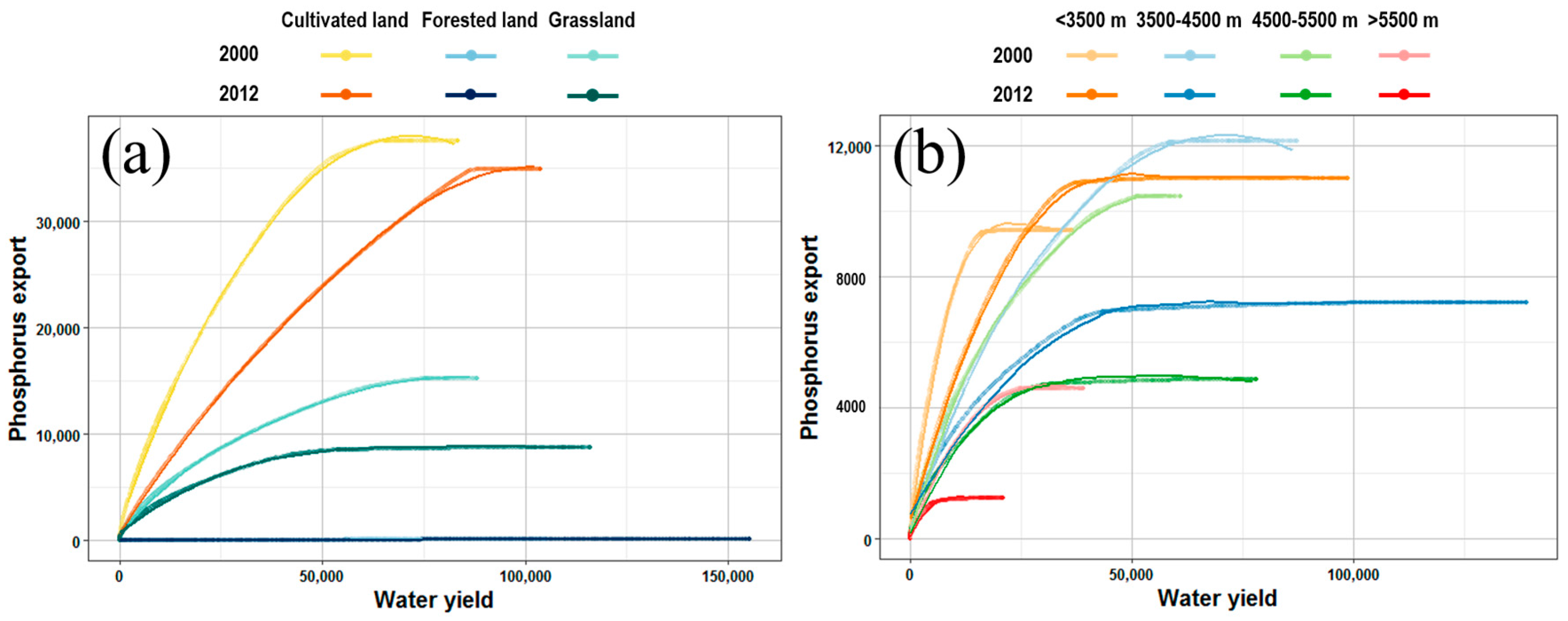
| Year | Ecosystem Service | NPP | Water Yield | Soil Conservation | P Export |
|---|---|---|---|---|---|
| 2000 | NPP | 1 | |||
| Water yield | 0.699 *** | 1 | |||
| Soil conservation | 0.383 *** | 0.407 *** | 1 | ||
| P export | 0.309 *** | 0.500 *** | 0.224 *** | 1 | |
| 2012 | NPP | 1 | |||
| Water yield | 0.761 *** | 1 | |||
| Soil conservation | 0.338 *** | 0.294 *** | 1 | ||
| P export | 0.095 *** | 0.178 *** | 0.066 *** | 1 |
© 2017 by the authors. Licensee MDPI, Basel, Switzerland. This article is an open access article distributed under the terms and conditions of the Creative Commons Attribution (CC BY) license (http://creativecommons.org/licenses/by/4.0/).
Share and Cite
Han, Z.; Song, W.; Deng, X.; Xu, X. Trade-Offs and Synergies in Ecosystem Service within the Three-Rivers Headwater Region, China. Water 2017, 9, 588. https://doi.org/10.3390/w9080588
Han Z, Song W, Deng X, Xu X. Trade-Offs and Synergies in Ecosystem Service within the Three-Rivers Headwater Region, China. Water. 2017; 9(8):588. https://doi.org/10.3390/w9080588
Chicago/Turabian StyleHan, Ze, Wei Song, Xiangzheng Deng, and Xinliang Xu. 2017. "Trade-Offs and Synergies in Ecosystem Service within the Three-Rivers Headwater Region, China" Water 9, no. 8: 588. https://doi.org/10.3390/w9080588





